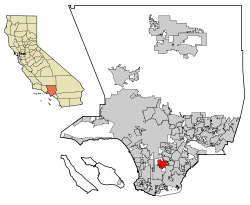Compton, CA
| City of Compton | ||||||
|---|---|---|---|---|---|---|
| Charter city | ||||||
|
||||||
|
||||||
| Nickname(s): Hub City | ||||||
| Motto: Birthing a New Compton | ||||||
 Location of Compton in Los Angeles County, California |
||||||
| Location in the United States | ||||||
| Coordinates: 33°53′48″N 118°13′30″W / 33.89667°N 118.22500°WCoordinates: 33°53′48″N 118°13′30″W / 33.89667°N 118.22500°W | ||||||
| Country | United States | |||||
| State | California | |||||
| County | Los Angeles | |||||
| Incorporated | May 11, 1888 | |||||
| Government | ||||||
| • Type | Council-Manager | |||||
| • City council |
Mayor: Aja Brown Janna Zurita Isaac Galvan Tana McCoy Emma Sharif |
|||||
| • City manager | Rodger L. Haley | |||||
| • City attorney | Craig J. Cornwell | |||||
| • City treasurer | Douglas Sanders | |||||
| • City clerk | Alita Godwin | |||||
| Area | ||||||
| • Total | 10.116 sq mi (26.202 km2) | |||||
| • Land | 10.012 sq mi (25.932 km2) | |||||
| • Water | 0.104 sq mi (0.270 km2) 1.03% | |||||
| Elevation | 69 ft (21 m) | |||||
| Population (April 1, 2010) | ||||||
| • Total | 96,455 | |||||
| • Estimate (2013) | 97,877 | |||||
| • Density | 9,500/sq mi (3,700/km2) | |||||
| Time zone | Pacific (UTC−8) | |||||
| • Summer (DST) | PDT (UTC−7) | |||||
| ZIP codes | 90220–90224 | |||||
| Area codes | 310/424 | |||||
| FIPS code | 06-15044 | |||||
| GNIS feature IDs | 1652689, 2410213 | |||||
| Website | www |
|||||
Compton is a city in southern Los Angeles County, California, United States, situated south of downtown Los Angeles. Compton is one of the oldest cities in the county and on May 11, 1888, was the eighth city to incorporate. As of the 2010 United States Census, the city had a total population of 96,455. It is known as the "Hub City" due to its geographic centrality in Los Angeles County. Neighborhoods in Compton include Sunny Cove, Leland, Downtown Compton, and Richland Farms. The city is generally a working class city with some middle-class neighborhoods, and is home to a relatively young community, at an average 25 years of age, compared to the American median age of 35 (2010 data).
In 1784, the Spanish Crown deeded a tract of over 75,000 acres (300 km2) to Juan Jose Dominguez in this area. The tract was named Rancho San Pedro. Dominguez's name was later applied to the Dominguez Hills community south of Compton. The tree that marked the original northern boundary of the rancho still stands at the corner of Poppy and Short streets. The rancho was subdivided and parcels were sold within the Californios of Alta California until the lands were ceded after the Mexican-American war in 1848. American immigrants acquired most of the rancho lands after 1848.
In 1867, Griffith Dickenson Compton led a group of 30 pioneers to the area. These families had traveled by wagon train south from in search of ways to earn a living other than in the rapid exhaustion of gold fields. Originally named Gibsonville, after one of the tract owners, it was later called Comptonville. However, to avoid confusion with the Comptonville located in Yuba County, the name was shortened to Compton. Compton's earliest settlers were faced with terrible hardships as they farmed the land in bleak weather to get by with just the barest subsistence. The weather continued to be harsh, rainy and cold, and fuel was difficult to find. To gather firewood it was necessary to travel to mountains close to Pasadena. The round trip took almost a week. Many in the Compton party wanted to relocate to a friendlier climate and settle down, but as there were two general stores within traveling distance—one in the pueblo of Los Angeles, the other in Wilmington—they eventually decided to stay put.
...
Wikipedia






